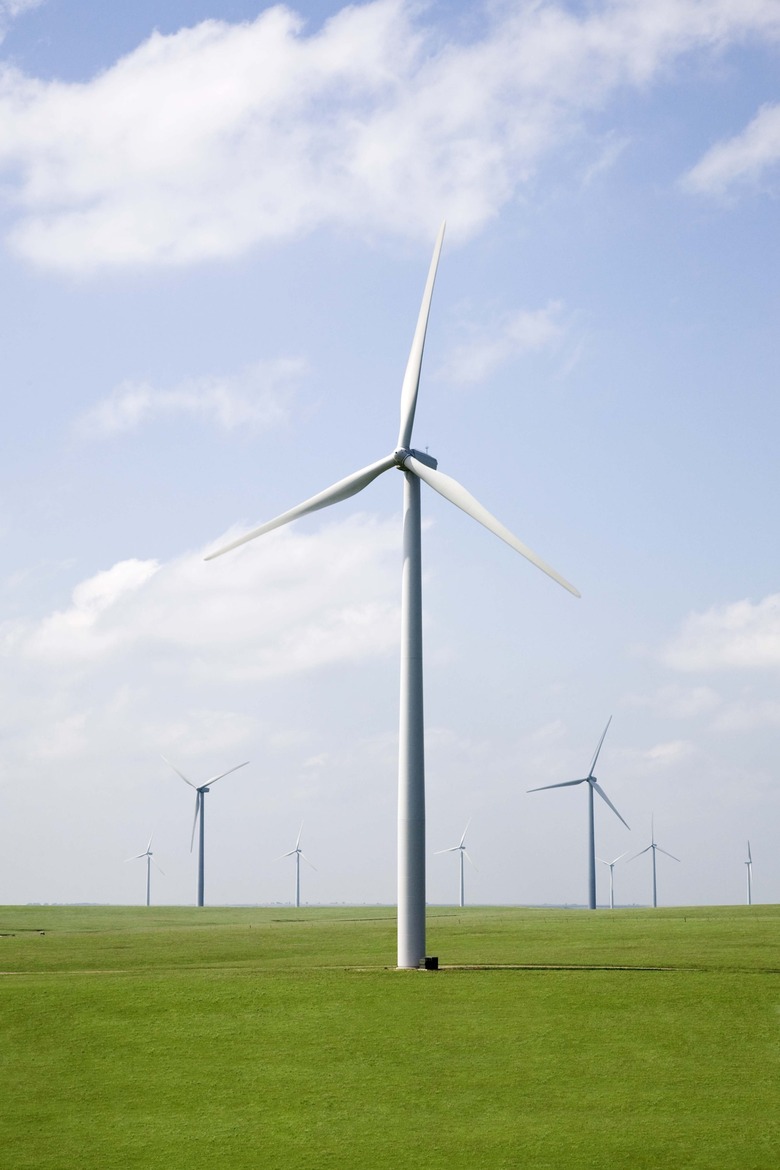Wind Turbine Size Vs. Power
Humans have been using wind power for thousands of years, but renewed interest non-fossil-fuel-based energy generation has led to a rapid increase in the spread of wind turbines. Extracting energy from wind is conceptually simple: wind moves over fan blades that turn a shaft that rotates an electric generator. The power capacity of a wind turbine is easily calculated, and yes, it does depend on turbine size.
Energy in Wind
Wind consists of air in motion and is made up of gaseous molecules. The kinetic energy of any single air molecule is equal to one half of its mass times its velocity squared. When wind is blowing, the mass of air that passes through any particular area is equal to the area times the wind velocity times the density of the air. Putting those two pieces together, the energy contained in wind blowing through a given area is equal to one-half the air density times the area times the velocity cubed. A quick way of calculating the power in wind, in watts per square meter, is to multiply the cube of the wind speed in meters per second by 0.625. If the wind speed is in miles per hour, you multiply the cube by 0.056. That means a 12-meter-per-second (just over 5 miles per hour) wind carries nearly 1,100 watts per square meter, while a 4-meter-per-second (less than 2 miles per hour) breeze carries just 40 watts per square meter. The wind speed that is three times greater carries 27 times more energy.
Swept Area
The swept area of a wind turbine is the total area covered by a rotation of the blades. For the familiar horizontal-axis wind turbines with two or more blades that spin in a circle, the swept area is equal to pi times the length of a single blade. On a machine with a 40-meter (131-foot) blade length, the swept area is more than 5,000 square meters (nearly 54,000 square feet) — almost one-and-a-quarter acres. The power going through that area can be calculated by multiplying 5,000 square meters by 0.625 times the wind speed cubed for a 12-meter-per-second wind, showing that the wind blowing through that area carries more than 5 megawatts of power. The same wind blowing past a turbine with 28-meter (92-foot) blades has a swept area of about 2,500 square meters (27,000 square feet), and carries about 2.5 megawatts of power.
Efficiency
Just because the wind carries a certain amount of power through a wind turbine's swept area does not mean the wind turbine produces that much power. In fact, even the best possible turbine cannot harvest all that energy. If it did, then the air immediately behind the blades would be still, which means the wind in front would have nowhere to go. The maximum possible amount of energy a wind turbine can harvest is less than 60 percent of the total. In the real world, other inefficiencies creep in — things like energy lost to friction, noise, and resistance in wires — to reduce the overall power extraction down to about 30 to 40 percent of the total wind power.
Capacity Factor
Every wind turbine carries a power rating. That's the maximum power it will produce for every moment the turbine operates at its rated wind speed. Unfortunately, every turbine has a different rated wind speed, making it a little more difficult to compare them. In addition, every turbine has a cut-in and cut-out speeds. Those are, respectively, the low and high wind speeds beyond which the turbine produces no electricity. The efficiency of the turbine between those two extremes is measured in a power curve. The amount of energy a wind turbine can be expected to produce in a given year depends upon the power curve and the wind speed profile. The actual energy produced divided by the energy the turbine could produce if it always ran full time is called the capacity factor. Although a larger wind turbine will generally be able to capture more wind energy, it might not have the highest capacity factor in a given location.
Cite This Article
MLA
Gaughan, Richard. "Wind Turbine Size Vs. Power" sciencing.com, https://www.sciencing.com/wind-turbine-size-vs-power-23676/. 24 April 2017.
APA
Gaughan, Richard. (2017, April 24). Wind Turbine Size Vs. Power. sciencing.com. Retrieved from https://www.sciencing.com/wind-turbine-size-vs-power-23676/
Chicago
Gaughan, Richard. Wind Turbine Size Vs. Power last modified March 24, 2022. https://www.sciencing.com/wind-turbine-size-vs-power-23676/
